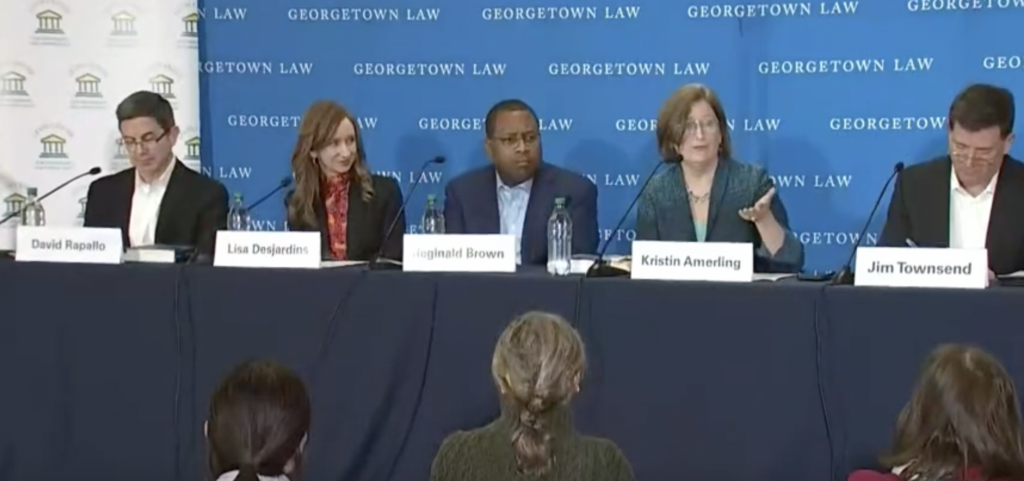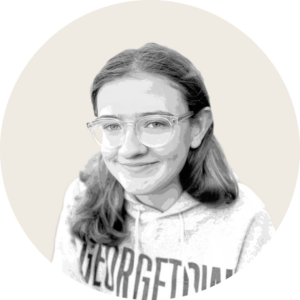The Georgetown University Law Center partnered with the Carl Levin Center for Oversight and Democracy, an organization dedicated to increasing government accountability, to host a panel on the implications of the House Jan. 6 Select Committee’s hearings on future congressional oversight.
At the Jan. 30 event, titled “How the January 6 Committee Broke the Mold: What it Means for Future Oversight,” speakers discussed how the committee’s format — in particular, its use of a television consultant, documentary style and choice of specific committee members to present and question witnesses — will impact future congressional hearings. James Townsend, the director of the Levin Center, moderated the conversation, and panelists included attorney Reginald Brown and PBS congressional correspondent Lisa Desjardins, as well as David Rapallo, an associate professor at the Law Center, and Kristin Amerling, the committee’s chief counsel and deputy staff director.
Amerling, an experienced congressional staffer, said the public mischaracterized many of the committee’s formatting choices as new or different from standard practice. The choice to have only one or two committee members question each witness is typical for congressional hearings, according to Amerling.
It was the members’ collective agreement to work together that distinguished the committee’s hearings from past oversight hearings, according to Amerling.
“The foundational feature of the Select Committee’s work that enabled use of these procedures was the commitment across the entire committee’s membership to work collaboratively to advance their investigative goal, which was to uncover what happened on Jan. 6, why it happened and make recommendations to make sure something like that never happens again,” Amerling said at the event.
The committee’s hearings notably brought a limited number of witnesses into hearing rooms in person, with many witnesses testifying over video. The committee hired television consultants and a producer to shape the hearings into docudrama-style episodes, detailing the full story of the Jan. 6 insurrection on primetime TV.
In its Dec. 22 final report, the committee concluded that former President Donald Trump incited the Jan. 6 riot and pressured state officials into providing false results for the 2020 election, recommending that Trump be banned from holding public office.
Brown, an attorney who represented witnesses testifying before the committee, said that the committee’s use of video effectively conveyed the dire nature of events inside the executive branch that led up to the insurrection at the Capitol.
“They also did an amazing job of telling the story of how close we came to losing aspects of our democracy, having the government crumble,” Brown said at the event. “And the only way to do that was by limiting the number of speakers and focusing on particular parts of the narrative through the use of video and live in-person testimony.”

Desjardins said the committee’s careful planning of how to deliver information created a more persuasive argument for a TV audience. The broadcast of the first primetime hearing reached at least 20 million viewers.
“This was an incredibly made-for-TV series of hearings,” Desjardins said at the event. “It was the use of compelling video and very carefully scripted wording which was tailored to each member, I think, and driven by each member.”
Rapallo served as a congressional and White House staffer for 23 years before joining the Law Center faculty, advising and serving on several special committees including those investigating Hurricane Katrina, the 2012 attack on an American diplomatic post in Benghazi, the COVID-19 pandemic and Trump’s impeachment.
The hearings’ documentary style made the committee’s findings more accessible to the general public, according to Rapallo.
“It’s like watching a series that has two-hour documentaries, where you have the same characters coming through as the members of Congress and then you get the new witnesses each time,” Rapallo said at the event. “At the beginning of the hearings, there was a recap of what happened last time and a preview of what you’re gonna hear here tonight. At the end of the hearing, there’s a recap of what you heard today and what you’re gonna hear at the next hearing.”
Desjardins said the committee intended to convince viewers of the executive branch’s involvement in the Capitol attack, not just explain a timeline of events.
“The focus was on not just the final report, but in telling it in a way that would change not just the pages of history — which I think the committee paid a lot of attention to — but hearts and minds of now,” Desjardins said. “They really were thinking about Republicans and independents in this country — that they think didn’t understand the danger, from the committee’s point of view, of what happened on Jan. 6.”
The committee’s success with these hearings required behind-the-scenes dedication to a common mission from both staffers and members, Amerling said.
“It involved a commitment to ongoing respectful conversations with each other, a spirit of accommodation and a willingness to put the overarching goals of the committee above individual egos,” Amerling said. “Democracy takes work and this committee was willing to do that work.”





















